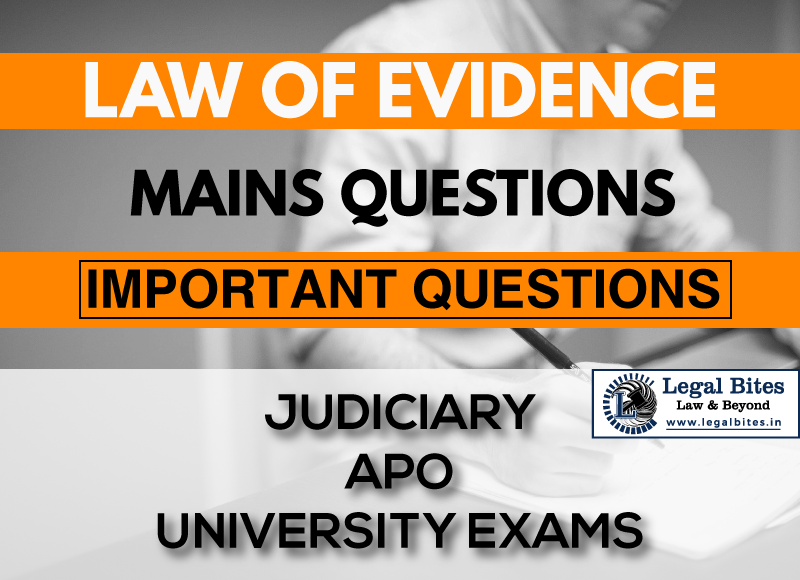‘A’ an accused was prosecuted and charged for the murder of B. There was no eye-witness (direct evidence) against A…. Are the aforesaid facts in the nature of circumstantial evidence sufficient to convict the accused A?
Question: ‘A’ an accused was prosecuted and charged for the murder of B. There was no eye-witness (direct evidence) against A. However, there was the following circumstantial evidence against A. The deceased was ‘last seen with the accused. The accused was giving a contradictory statement regarding the presence of the deceased, just before his murder, with the former.… Read More »
;
Question: ‘A’ an accused was prosecuted and charged for the murder of B. There was no eye-witness (direct evidence) against A. However, there was the following circumstantial evidence against A. The deceased was ‘last seen with the accused. The accused was giving a contradictory statement regarding the presence of the deceased, just before his murder, with the former. The dead body of the deceased was recovered at the instance of the accused. Are the aforesaid facts in the...
Question: ‘A’ an accused was prosecuted and charged for the murder of B. There was no eye-witness (direct evidence) against A. However, there was the following circumstantial evidence against A.
-
The deceased was ‘last seen with the accused.
-
The accused was giving a contradictory statement regarding the presence of the deceased, just before his murder, with the former.
-
The dead body of the deceased was recovered at the instance of the accused.
Are the aforesaid facts in the nature of circumstantial evidence sufficient to convict the accused A? Give reasons and also refer to the case law, if any, on the point.
Find the answer to the mains question only on Legal Bites. [‘A’ an accused was prosecuted and charged for the murder of B. There was no eye-witness (direct evidence) against A…. Are the aforesaid facts in the nature of circumstantial evidence sufficient to convict the accused A? Give reasons and also refer to the case law, if any, on the point.]
Answer
Last seen together by itself is not conclusive proof but along with other circumstances surrounding the incident, may lead to the inference of guilt of the accused. As held in Rohtash Kumar v. State of Haryana, 2013 Cr LJ 3183 (para 25) (SC), the doctrine of “last seen together” shifts the burden of proof on the accused, requiring him to explain how the incident had occurred.
Failure on the part of the accused to furnish any explanation in this regard would give rise to a very strong presumption against him. However circumstances leading to “last seen together”, do not necessarily imply that it was the accused who has committed the crime. If the circumstances are limited to just “last seen together” without further corroboration, a conviction cannot be based on the said assertion.
Thus, last seen together is not conclusive proof establishing guilt, it is imperative to look at surrounding circumstances such as victim relationship, history of hostility, weapon recovery, the relationship between the victim and the accused among others. In the case of Vithal Eknath Adlinge v. State of Maharashtra, AIR 2009 SC 2067, it was held that the proximity between the time of death and last seen together is essential to conclude that the accused and deceased were last seen together without the probability of other persons coming in between exists.
In reference to cases where there is no direct evidence and the decision has to rest on circumstantial evidence, the Supreme Court in a line of decisions has consistently held that such evidence must satisfy the following tests:
- the circumstances from which an inference of guilt is sought to be drawn must be cogently and firmly established;
- those circumstances should be of a definite tendency unerringly pointing towards the guilt of the accused;
- the circumstances, taken cumulatively, should form a chain so complete that there is no escape from the conclusion that within all human probability the crime was committed by the accused and none else; and
- the circumstantial evidence in order to sustain conviction must be complete and incapable of explanation on any other hypothesis than that of the guilt of the accused and such evidence should not only be consistent with the guilt of the accused but should be inconsistent with his innocence
Based on the above reasoning, it can be said in the present case at hand, that the aforesaid facts in the nature of circumstantial evidence are sufficient to convict accused A because, besides the last seen theory, there are sufficient explanations to prove the guilt of the accused.
Important Mains Questions Series for Judiciary, APO & University Exams
- Law of Evidence Mains Questions Series Part-I
- Law of Evidence Mains Questions Series Part-II
- Law of Evidence Mains Questions Series Part-III
- Law of Evidence Mains Questions Series Part-IV
- Law of Evidence Mains Questions Series Part-V
- Law of Evidence Mains Questions Series Part-VI
- Law of Evidence Mains Questions Series Part-VII
- Law of Evidence Mains Questions Series Part-VIII
- Law of Evidence Mains Questions Series Part-IX
- Law of Evidence Mains Questions Series Part-X

